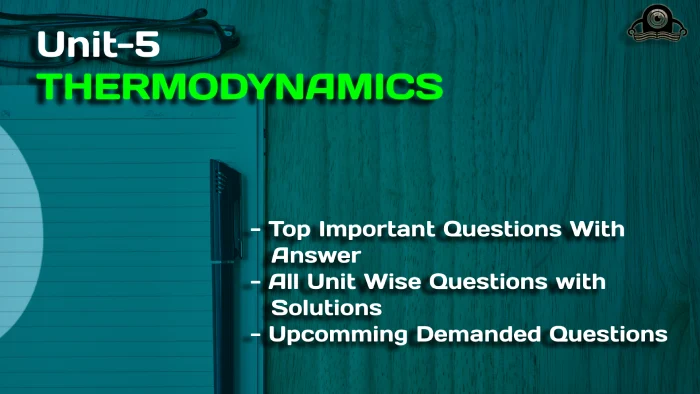In this unit, students will learn about refrigeration cycles, including their principles, applications, and limitations in thermodynamics in mechanical engineering.
Dudes 🤔.. You want more useful details regarding this subject. Please keep in mind this as well. Important Questions For Thermodynamics: *Unit-01 *Unit-02 *Unit-03 *Unit-04 *Unit-05 *Short-Q/Ans *Question-Paper with solution 21-22
Q1. Define the terms, ‘refrigeration effect’ and unit of refrigeration ?
Ans. A. Refrigeration Effect :
1. It is defined as the amount of cooling produced by a system.
2. Some energy was expended to achieve this cooling. Consequently, it is common practise to define the term “coefficient of performance.”
3. The coefficient of performance, or theoretical coefficient of performance, of a refrigerator is the ratio of heat extracted in the refrigerator to the work done on the refrigerant (COP).



B. Unit of Refrigeration :
1. The practical unit of refrigeration is expressed in terms of ‘tonne of refrigeration’ or TR.
2. A tonne of refrigeration is defined as the amount of refrigeration effect produced by the uniform melting of one tonne of ice at O °C in 24 hours. Since the latent heat of ice is 335 kJ / kg, therefore one tonne of refrigeration is given by,
Q2. Describe a reversed Carnot cycle with the help of a neat labelled sketch.
Ans. 1. The highest performance coefficient is achieved by a refrigeration system that uses the reversed Carnot cycle, but manufacturing such a machine has proven to be practically impossible because the isothermal portion of the stroke requires a very low speed while the adiabatic portion requires a high speed. It is not practical to stroke with this speed variation.
2. The working of reversed Carnot cycle are shown on p-v and T-s diagram below:






3. The four processes of the reversed Carnot cycle are as follows :
a. Isentropic Compression Process (1-2) :
1. During this process, the pressure of air increases fromp p1 to p2 specific volume decreases from v1 to v2 and temperature increases from T1 to T2 During isentropic compression, no heat is absorbed or rejected by the air.
b. Isothermal Compression Process (2-3):
1. During this process, the pressure of air increases from p2 to p3 and specific volume decreases from v2 to v3.
2. Heat rejected by the air during isothermal compression per kg of air is given by,



c. Isentropic Expansion Process (3-4) :
1. During this process, the pressure of air decreases from p3 to p4 , specific volume increases from v3 to v4 and the temperature decreases from T3 to T4.
d. Isothermal Expansion Process (4-1) :
1. During this process, the pressure of air decreases from p4 to p1 and specific volume increases from v4 to v1.
2. Heat absorbed by the air (or heat extracted from the cold body) during isothermal expansion per kg of air is given by,



3. Since, in a refrigerating machine, heat rejected is more than heat absorbed.
4. Therefore, work done during the cycle per kg of air



5. Therefore, coefficient of performance of the refrigeration system working on reversed Carnot cycle is given by,
Q3. Explain open and closed air refrigeration cycle.
Ans. A. Open Air Refrigeration Cycle :
- 1. In an open air refrigeration cycle, the air is immediately introduced to the area to be cooled, allowed to circulate through the cooler, and then redirected to the compressor to begin another cycle.
- 2. Since the compressor and expander handle a huge volume of air since the air is supplied to the refrigerator at atmospheric pressure.
- 3. As a result, the expander and compressor should be substantial in size.
B. Closed Air Refrigeration Cycle :
- 1. In a closed air refrigeration cycle, air is constantly circulated through the system’s pipes and component parts.
- 2. Heat is removed from the fluid (in this case, brine) using air, and the cooled brine is then cycled in the area that needs to be cooled.
- 3. The following benefits of the closed air refrigeration cycle:
- a. Because it may operate at suction pressures above atmospheric pressure, the volume handled by the compressor and expander is reduced.
- b. By lowering the operating pressure ratio, a high COP can be achieved.
Q4. Give the difference between open and closed air refrigeration cycles.
Ans.
| S. No. | Open air refrigeration cycle | Closed air refrigeration cycle |
| 1. | The air comes in contact directly with the space to be cooled. | The air does not come in contact with the space to be cooled. |
| 2. | The size of compressor and expander is large. | By using dense air, the size of the compressor can be kept within a tolerable range. |
| 3. | It requires drier. | It does not require any drier. |
| 4. | COP is lower. | COP is higher. |
| 5. | The refrigerant’s expansion can only be changed up to the air pressure present in the cold chamber. | There is no such restriction. |
Q5.Describe vapour compression refrigeration system and what are its advantages over air refrigeration system ?
Ans. A. Vapour Compression Refrigeration System :
- 1. It is a more advanced form of air refrigeration system that employs the usage of a refrigerant, a suitable working ingredient.
- 2. The system does not let the refrigerant out. The system is circulated while alternately condensing and evaporating.
- 3. The refrigerant acquires its latent heat from the brine (salt water) used to circulate it across the chilly chamber as it evaporates.
- 4. As it condenses, it releases its latent heat to the cooler’s circulating water.
- 5. Because the vapour compression refrigeration system extracts latent heat from the brine and transfers it to the cooler, it is a latent heat pump.
B. Advantages of Vapour Compression Refrigeration System over Air Refrigeration System :
- 1. It has smaller size for the given capacity of refrigeration.
- 2. It has less running cost.
- 3. It can be employed over a large range of temperatures.
- 4. The coefficient of performance is quite high.
Q6. Describe the mechanism of a simple vapour compression refrigeration system.
Ans. This mechanism consists of following essential parts as shown in Fig.



a. Compressor :
1. The low pressure and temperature vapour r efrigerant from evaporator is drawn into the compressor through the inlet or suction valve A , where it is compressed to a high pressure and temperature.
2. This high pressure and temperature vapour refrigerant is discharged into the condenser through the delivery or discharge valve B .
b. Condenser :
1. The high pressure and temperature vapour refrigerant is cooled and condensed in the condenser or cooler, which is composed of coils of pipe.
2. As the refrigerant passes through the condenser, latent heat is transferred to the air or water that serves as the surrounding condensing medium.
c. Receiver :
1. From a container known as the receiver, where it is held until it is needed, the condensed liquid refrigerant from the condenser is fed to the evaporator through the expansion valve or refrigerant control valve.
d. Expansion Valve :
1. Other names for it are throttle and refrigerant control valve.
2. The expansion valve’s job is to let high-pressure, high-temperature liquid refrigerant pass through at a controlled rate after its pressure and temperature are reduced.
e. Evaporator :
1. A pipe coils make up an evaporator, which is where the liquid-vapour refrigerant is evaporated and converted into vapour refrigerant at low pressure and temperature.
2. During evaporation, the medium (air, water, or brine) that is being cooled absorbs the liquid vapour refrigerant’s latent heat of vapourization.



Important Question with solutions | AKTU Quantums | Syllabus | Short Questions
Thermodynamics Quantum, Syllabus, Important Questions
| Label | Link |
|---|---|
| Subject Syllabus | Syllabus |
| Short Questions | Short-question |
| Important Unit-1 | Unit-1 |
| Important Unit-2 | Unit-2 |
| Important Unit-3 | Unit-3 |
| Important Unit-4 | Unit-4 |
| Important Unit-5 | Unit-5 |
| Question paper – 2021-22 | 2021-22 |
Thermodynamics Quantum PDF: | AKTU Quantum PDF:
| Quantum Series | Links |
| Quantum -2022-23 | 2022-23 |
AKTU Important Links | Btech Syllabus
| Link Name | Links |
|---|---|
| Btech AKTU Circulars | Links |
| Btech AKTU Syllabus | Links |
| Btech AKTU Student Dashboard | Student Dashboard |
| AKTU RESULT (One VIew) | Student Result |

1 thought on “Unit 05 Thermodynamic Refrigeration Cycles”